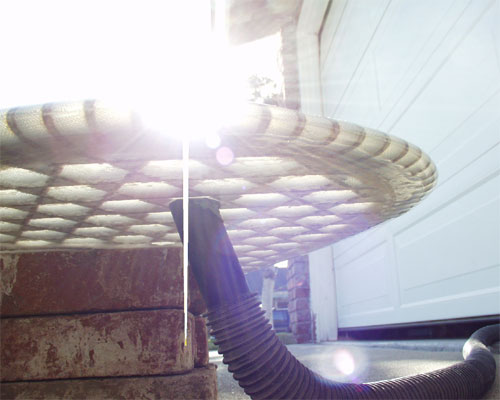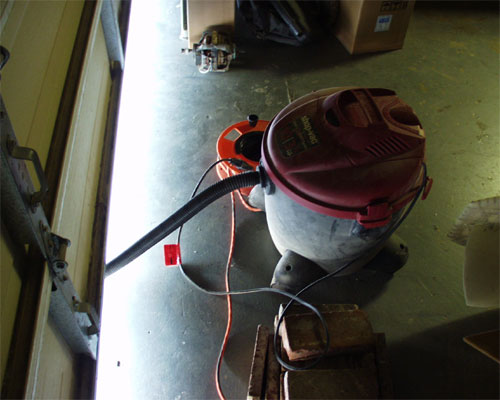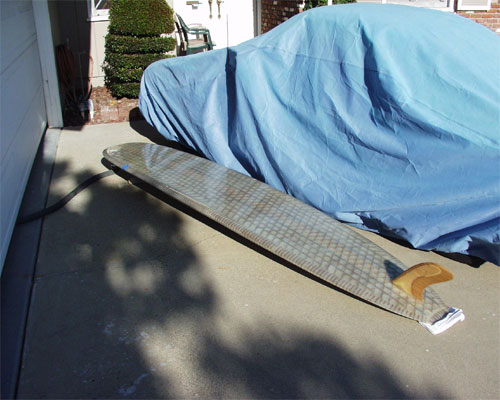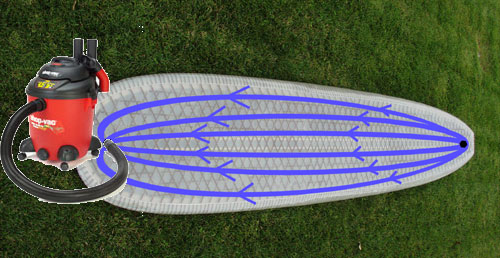|
Dry Out
With airflow and heat, these boards can be dried out within a day or two. The cardboard structure remains intact. The primary cause of leaks is undetected pinholes in over-sanded areas of the glass job. If you ended up with a pinhole in your glass job, you'll discover it the first or second time you use the board. When the board hits cold water it will suck a noticable amount of water through the smallest hole or fissure. So check a new board for leaks every few waves on the first couple days you take it out. If your glass job is good and watertight from the start, it will likely stay that way. So don't worry about leaks after the first few go-outs. Obviously, dings are the second reason boards leak. Either way, the board simply needs to be dried and patched. 
The dry-out process has turned out to be faster and simpler than I expected. This board had a small leak along the rail, about a third of the way from the front. Most of the water was in a roughly six-inch diameter area. I cut a hole near each end of the board, put the board in the sun, bottom up, so the wax wouldn't melt off, and stuck a ShopVac hose in the front hole. 
Once the board warmed enough to generate condensation in the wet area, I switched on the Shop-Vac. I would run it in 15 to 20 minute sessions, kind of thinking I should let the board warm up between sessions, but mostly thinking how annoying it must be to be my neighbor right now. 
I started the process at about 11:30 a.m. on the morning I got the board wet. Ambient temperature was in the mid seventies.
At 2:30 p.m., the board seemed dry, and the creeping shade was about to shut down my sunning spot. So I decided to weigh the board to see how much progress I had made. Three hours. I could have done it in less if I had run the Shop-Vac the whole time. Next time I'll try it without sun - just the vacuum in the garage, with the board on a scale, collecting weight loss and time data. (This board actually leaked twice, through the same hole. The first dry-out took two days because I relied more on sun and less on air flow that time. I didn't find the hole that first time. The faster dry-out session pictured here is from after it leaked the second time. I found the very tiny hole this time.) How it Works: Flow, and Hole Placement
The core structure is made of notched ribs that slide into each other. Each notch has a little half circle cut out of its side for ventilation. So every hexagon and triangle cell in the structure is open to its neighbors. This allows airflow throughout the enitre structure, facilitating dry out. In the core design with seperate, radial rail pieces, air flows more freely from end to end along the region where the rail pieces meet the core. When water has migrated into cells near the center of the board, we want to get airflow moving through the network of core cells, as well as the rail areas. To get air moving through both regions, the ventilation holes should be cut a little way into the core structure. I'd like to figure out exactly where to put the holes to balance out the air flowing through the core versus the rails. That would be a fun CFD problem, somewhat like figuring out how air flows through the doors and windows of a large building. I have other core designs in mind that would seek to optimize dry-out airflow. But that's not really necessary. The current core drys well enough. Your intuition should be adequate for placing the ventilation holes. Is It All-The-Way Dry?
Weigh it, if you can. I happen to have an old digital grocery or butcher scale that reads out to hundreths of a pound, and can handle more than 25 pounds. During the drying process, I can check my progress. When the weight stops going down, the board is dry, probably - but maybe dry it a little more just to be sure. If you can't find a good scale, go by visual inspection. A damp board set out in the sun will produce condensation in the damp cells that you will be able to see. Keep at the dryout process - heat/sun and airflow - until all the condensation in all of the cells goes away and stays away, and then keep at the process a while longer, just to be sure. Another clue that the board is dry is that the edges of the cardboard in the sections that were wettest the longest tend to turn a light brown. If the cardboard was not totally saturated, this may not happen. But if it does happen, that section is dry, or close to it. Last Resort
You could just cut some ventilation holes and put the board away for weeks or months, preferably in a warm, not-too-humid place. My first board leaked and stayed wet inside for months. After drilling holes in it, I checked it after a few more months and found that it was dry. It's still rigid. I'm sure long-term water exposure, or any water exposure, must weaken the structure somewhat, but any degradation has not been noticable in the boards I've dryed, repaired and ridden. Conclusion
The dry-out process is fairly standard and predictable. It is a feature of the core design that you can flow air through the whole structure. Water, too, can easily migrate from cell to cell, but, with cardboard, that's going to happen anyway. You can't fight it, so let it flow. Then make it flow out and suck the structure dry. The board remains intact and functional. |
